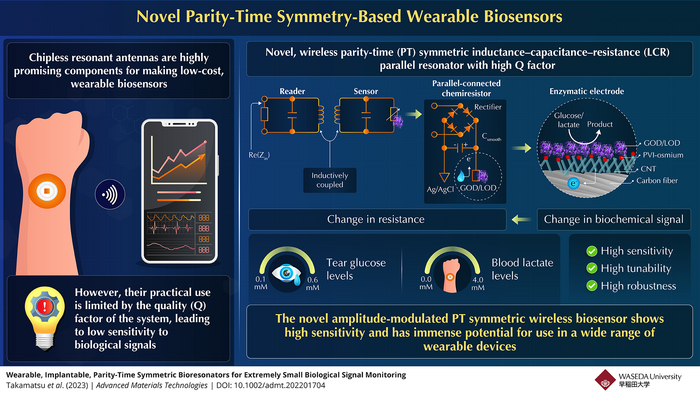Wireless wearable biosensors have been a game changer in personalized health monitoring and healthcare digitization because they can efficiently detect, record, and monitor medically significant biological signals. Chipless resonant antennae are highly promising components of wearable biosensors, as they are affordable and tractable. However, their practical applications are limited by low sensitivity (inability to detect small biological signals) caused by low quality (Q) factor of the system.

Credit: Professor Takeo Miyake from Waseda University
Wireless wearable biosensors have been a game changer in personalized health monitoring and healthcare digitization because they can efficiently detect, record, and monitor medically significant biological signals. Chipless resonant antennae are highly promising components of wearable biosensors, as they are affordable and tractable. However, their practical applications are limited by low sensitivity (inability to detect small biological signals) caused by low quality (Q) factor of the system.
To overcome this hurdle, researchers led by Professor Takeo Miyake from Waseda University, Professor Yin Sijie from Beijing Institute of Technology, and Taiki Takamatsu from Japan Aerospace Exploration Agency, have developed a wireless bioresonator using “parity–time (PT) symmetry” that can detect minute biological signals. Their work has been published in Advanced Materials Technologies.
In this study, the researchers designed a bioresonator consisting of a magnetically coupled reader and sensor with high Q factor, and thus, increased sensitivity to biochemical changes. The reader and sensor both comprise an inductor (L) and capacitor (C) that are parallel-connected to a resistor (R). In the sensor, the resistor is a chemical sensor called a “chemiresistor” that converts biochemical signals into changes in resistance. The chemiresistor contains an enzymatic electrode with an immobilized enzyme. Minute biochemical changes at the enzymatic electrode (in response to changes in the levels of biomolecules such as blood sugar or lactate) are thus converted into electrical signals by the sensor, and then amplified at the reader.
Explaining the technical concept behind their novel biosensor, Miyake says, “We modeled the characteristics of the PT-symmetric wireless sensing system by using an eigenvalue solution and input impedance, and experimentally demonstrated the sensitivity enhancement at/near the exceptional point by using parallel inductance–capacitance–resistance (LCR) resonators. The developed amplitude modulation-based PT-symmetric bioresonator can detect small biological signals that have been difficult to measure wirelessly until now. Moreover, our PT-symmetric system provides two types of readout modes: threshold-based switching and enhanced linear detection. Different readout modes can be used for different sensing ranges.”
The researchers tested the system (here containing a glucose-specific enzyme) on human tear fluids and found that it could detect glucose concentrations ranging from 0.1 to 0.6 mM. They also tested it with a lactate-specific enzyme and commercially available human skin and found that it could measure lactate levels in the range of 0.0 to 4.0 mM through human skin tissue, without any loss of sensitivity. This result further indicates that the biosensor can be used as an implantable device. Compared to a conventional chipless resonant antenna-based system, the PT-symmetric system achieved a 2000-fold higher sensitivity in linear and a 78% relative change in threshold-based detection respectively.
Sharing his vision for the future, Miyake concludes, “The present telemetry system is robust and tunable. It can enhance the sensitivity of sensors to small biological signals. We envision that this technology can be used for developing smart contact lenses to detect tear glucose and/or implantable medical devices to detect lactate for efficient monitoring of diabetes and blood poisoning.”
This novel PT-symmetric wireless wearable bioresonator may soon usher in a new era of personalized health monitoring and efficient digitized healthcare systems!
***
Reference
DOI: https://doi.org/10.1002/admt.202201704
Authors: Taiki Takamatsu1, Yin Sijie1, Takeo Miyake1,2
Affiliations:
1 Faculty of Science and Engineering, Graduate School of Information, Production and Systems, Waseda University, Japan
2 PRESTO, Japan Science and Technology Agency, Japan
About Professor Takeo Miyake
Takeo Miyake is a Professor at the Faculty of Science and Engineering, Graduate School of Information, Production, and Systems, Waseda University. His research interests include bioiontronics, wireless power supply, bioprotonics, bioelectronics, biofuel battery, etc. He is a member of the Materials Research Society, the Surface Science Society of Japan, and the Japan Society of Applied Physics. He has published more than 50 articles in reputed journals. Miyake has received many awards including the Commendation for Science and Technology in 2020 by the Ministry of Education, Culture, Sports, Science and Technology.
About Waseda University
Located in the heart of Tokyo, Waseda University is a leading private research university that has long been dedicated to academic excellence, innovative research, and civic engagement at both the local and global levels since 1882. The University has produced many changemakers in its history, including nine prime ministers and many leaders in business, science and technology, literature, sports, and film. Waseda has strong collaborations with overseas research institutions and is committed to advancing cutting-edge research and developing leaders who can contribute to the resolution of complex, global social issues. The University has set a target of achieving a zero-carbon campus by 2032, in line with the Sustainable Development Goals (SDGs) adopted by the United Nations in 2015.
To learn more about Waseda University, visit https://www.waseda.jp/top/en
Journal
Advanced Materials Technologies
DOI
10.1002/admt.202201704
Method of Research
Experimental study
Subject of Research
Not applicable
Article Title
Wearable, Implantable, Parity-Time Symmetric Bioresonators for Extremely Small Biological Signal Monitoring
Article Publication Date
8-Apr-2023
COI Statement
The authors declare no competing interests




